Related Research Articles

Tiberius Claudius Caesar Augustus Germanicus was Roman emperor, ruling from AD 41 to 54. A member of the Julio-Claudian dynasty, Claudius was born to Drusus and Antonia Minor at Lugdunum in Roman Gaul, where his father was stationed as a military legate. He was the first Roman emperor to be born outside Italy.

Claudius Ptolemy was an Alexandrian mathematician, astronomer, astrologer, geographer, and music theorist, who wrote about a dozen scientific treatises, three of which were of importance to later Byzantine, Islamic, and Western European science. The first is the astronomical treatise now known as the Almagest, although it was originally entitled the Mathēmatikē Syntaxis or Mathematical Treatise, and later known as The Greatest Treatise. The second is the Geography, which is a thorough discussion on maps and the geographic knowledge of the Greco-Roman world. The third is the astrological treatise in which he attempted to adapt horoscopic astrology to the Aristotelian natural philosophy of his day. This is sometimes known as the Apotelesmatika but more commonly known as the Tetrábiblos, from the Koine Greek meaning "Four Books", or by its Latin equivalent Quadripartite.
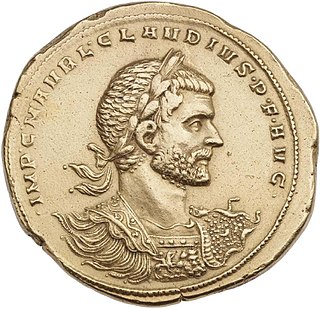
Marcus Aurelius Claudius "Gothicus", also known as Claudius II, was Roman emperor from 268 to 270. During his reign he fought successfully against the Alemanni and decisively defeated the Goths at the Battle of Naissus. He died after succumbing to a "pestilence", possibly the Plague of Cyprian that had ravaged the provinces of the Empire.

Valeria Messalina was the third wife of Roman emperor Claudius. She was a paternal cousin of Emperor Nero, a second cousin of Emperor Caligula, and a great-grandniece of Emperor Augustus. A powerful and influential woman with a reputation for promiscuity, she allegedly conspired against her husband and was executed on the discovery of the plot. Her notorious reputation probably resulted from political bias, but works of art and literature have perpetuated it into modern times.

Lucius Annaeus Seneca the Younger, usually known mononymously as Seneca, was a Stoic philosopher of Ancient Rome, a statesman, dramatist, and in one work, satirist, from the post-Augustan age of Latin literature.

Childebert II (c.570–596) was the Merovingian king of Austrasia from 575 until his death in March 596, as the only son of Sigebert I and Brunhilda of Austrasia; and the king of Burgundy from 592 to his death, as the adopted son of his uncle Guntram.
Claudius Claudianus, known in English as Claudian, was a Latin poet associated with the court of the Roman emperor Honorius at Mediolanum (Milan), and particularly with the general Stilicho. His work, written almost entirely in hexameters or elegiac couplets, falls into three main categories: poems for Honorius, poems for Stilicho, and mythological epic.

Jovian was Roman emperor from June 363 to February 364. As part of the imperial bodyguard, he accompanied Emperor Julian on his campaign against the Sasanian Empire. Julian was killed in battle, and the exhausted and ill-provisioned army declared Jovian his successor. Unable to cross the Tigris, Jovian extricated his troops from enemy territory by making peace with the Sasanids on humiliating terms. He spent the rest of his eight-month reign traveling back to Constantinople. After his arrival at Edessa, Jovian was petitioned by bishops over doctrinal issues concerning Christianity. He died at Dadastana, never having reached the capital.
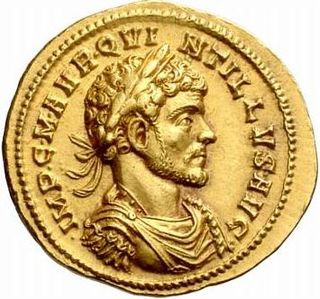
Marcus Aurelius Claudius Quintillus was a Roman emperor. He was a brother of Emperor Claudius Gothicus, whom he succeeded after Claudius' death in 270. Quintillus' claim to be emperor was challenged by Aurelian, who was proclaimed emperor by the legions he commanded. Quintillus' reign lasted no more than six months. Different sources report his cause of death as murder by his own soldiers, in battle with Aurelian, or by suicide.
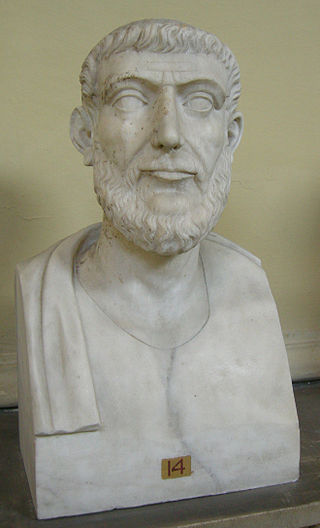
Appius Claudius Caecus was a statesman and writer from the Roman Republic. He is best known for two major building projects: the Appian Way, the first major Roman road, and the first aqueduct in Rome, the Aqua Appia.

The gens Claudia, sometimes written Clodia, was one of the most prominent patrician houses at ancient Rome. The gens traced its origin to the earliest days of the Roman Republic. The first of the Claudii to obtain the consulship was Appius Claudius Sabinus Regillensis, in 495 BC, and from that time its members frequently held the highest offices of the state, both under the Republic and in imperial times.
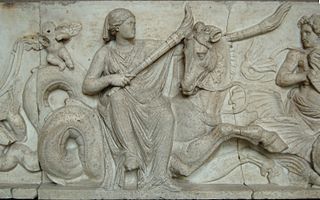
Doris, in Greek mythology, was a sea goddess. She was one of the 3,000 Oceanids, daughters of the Titans Oceanus and Tethys.
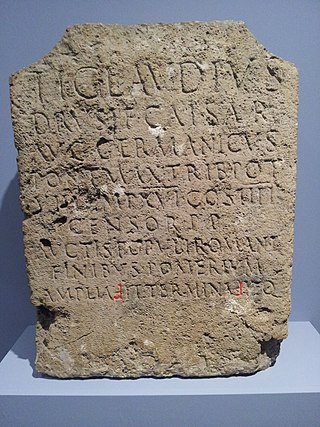
The Claudian letters were developed by the Roman emperor Claudius. He introduced three new letters to the Latin alphabet:
The Tubantes were a Germanic tribe, living in the eastern part of the Netherlands, north of the Rhine river. They are often equated to the Tuihanti, who are known from two inscriptions found near Hadrian's Wall. The modern name Twente derives from the word Tuihanti.
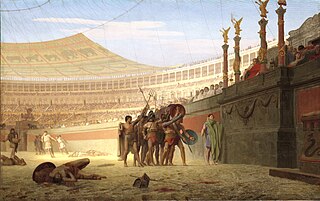
Avē Imperātor, moritūrī tē salūtant is a well-known Latin phrase quoted in Suetonius, De vita Caesarum. It was reportedly used during an event in AD 52 on Lake Fucinus by naumachiarii—captives and criminals fated to die fighting during mock naval encounters—in the presence of the emperor Claudius. Suetonius reports that Claudius replied "Aut nōn".

The Praetorian Prefecture of Gaul was one of four large prefectures into which the Late Roman Empire was divided.

The Diocese of Thrace was a diocese of the later Roman Empire, incorporating the provinces of the eastern Balkan Peninsula. Philippopolis was the capital.

Rufius Achilius Sividius was a Roman senator under Odoacer's rule. His brothers included Rufius Achilius Maecius Placidus, and Anicius Acilius Aginantius Faustus.
The Roman conquest of the Hernici, an ancient Italic people, took place during the 4th century BC. For most of the 5th century BC, the Roman Republic had been allied with the other Latin states and the Hernici to successfully fend off the Aequi and the Volsci. In the early 4th century BC, this alliance fell apart. A war fought between Rome and the Hernici in the years 366–358 BC ended in Roman victory and the submission of the Hernici. Rome also defeated a rebellion by some Hernician cities in 307–306 BC. The rebellious Hernici were incorporated directly into the Roman Republic, while those who had stayed loyal retained their autonomy and nominal independence. In the course of the following century, the Hernici became indistinguishable from their Latin and Roman neighbours and disappeared as a separate people.

Theodore was the bishop of Marseille from at least 566 until 591/594. In the 580s, Theodore was at the centre of a dispute over the city of Marseille between King Guntram and his nephew, King Childebert II. He was arrested several times. His troubles are recorded by the contemporary historian Gregory of Tours, who depicts him as a saintly albeit powerless figure who was supported by the laity, but opposed by his own clergy.